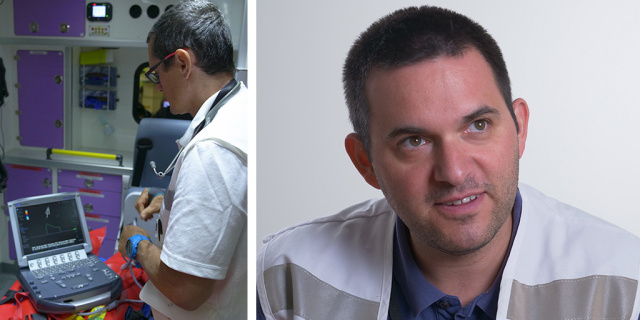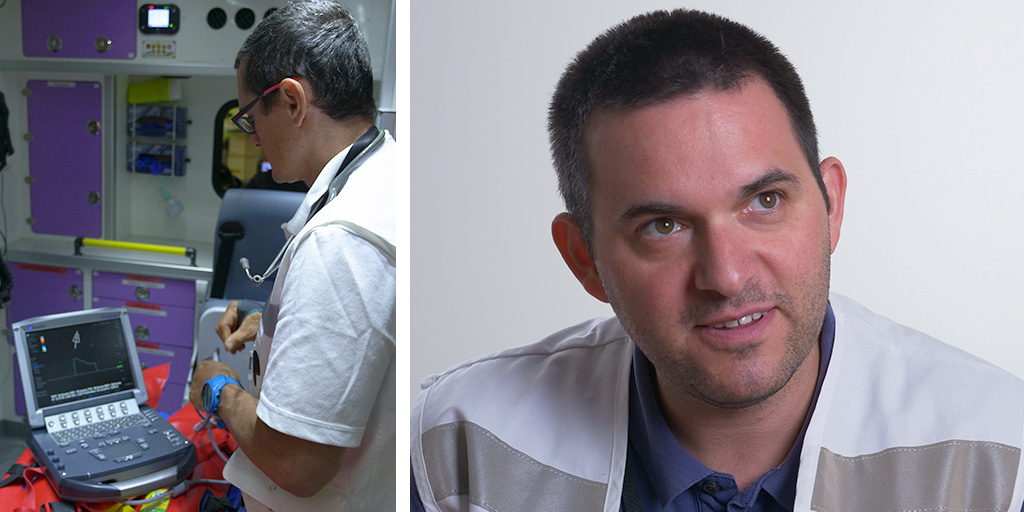

Emergency physicians must make life-saving decisions as quickly as possible to choose the correct treatment and direct patients to an appropriate hospital. Emergency department chief Dr. Sylvain Benenati and emergency doctor Dr. David Sapir, both from Melun Hospital in France, discuss how the dynamic nature of point-of-care ultrasound makes it invaluable in these busy environments.
POCUS on the Road
Melun Hospital is located about 40 kilometers south of Paris. It is the headquarters of the urgent medical aid service (SAMU) for Seine et Marne—the biggest department in the Paris area—as well as the mobile emergency and resuscitation service (SMUR). The SAMU is responsible for dispatching SMUR emergency vehicles. The three SMUR units in Melun and the medical helicopter based nearby all carry point-of-care-ultrasound (POCUS) systems in their vehicles. Having POCUS is beneficial in many situations, from diagnosing a range of conditions to monitoring patient transfers to the most suitable hospital, as Dr. Sapir explains:
“I've been working as a clinician specialising in emergency medicine for the past 20 years—10 of them using ultrasound routinely. I spend a lot of time on ambulances attending emergency situations where we often don’t know anything about the patients. In pre-hospital medicine, we don’t carry out a full exam, but perform targeted ultrasound to get quick answers. This way, we can rule out any specific problems and determine how severe they are. The strength of ultrasound lies in resolving any grey areas that the clinical exam doesn’t show. Our ambulances and helicopters are equipped with FUJIFILM Sonosite ultrasound devices and two probes – one an abdominal, cardiac and transcranial probe, the other a high-frequency, linear probe for compression venous ultrasound, pulmonary examinations, and ultrasound-guided catheterization.”
Dr. Benenati adds:
“One of the most common problems where we use POCUS is to investigate chest pain and polytrauma, but it also supports the assessment of dyspnea, abdominal pain and shock, all of which need rapid attention. Having ultrasound equipment on the road—or in the air in the case of our helicopters—means that we can act swiftly and make suitable decisions as soon as possible. The combination of ultrasound with other equipment, such as defibrillators and ECGs, allows us to identify problems and initiate procedures like resuscitation before the patient even gets to the hospital—it can improve the functional prognosis and potentially be life-saving. Having POCUS has completely transformed the way in which we can work.”
A Point in the Right Direction
POCUS allows clinicians to make a quick assessment of the patient and decide where they should be directed in time-critical situations. Dr. Sapir describes these advantages:
“We make better decisions for the patient based on what we see using ultrasound. POCUS helps us decide whether to take the patient to a nearby general hospital or further away to a more suitable facility. We recently monitored how often we change the destination of a patient based on ultrasound assessment. This happens in about 20-25% of cases, which really highlights its importance to improve the patient’s treatment. On average, around one in four patients will change destination based on the information we gain. It’s incredible—a revolution”
Training the Next Generation
As the need for ultrasound in the pre-hospital setting becomes more apparent, more clinicians must be trained to use the equipment. Dr. Sapir explains:
“Currently, many doctors are untrained or less experienced in the technique, and would not feel comfortable using ultrasound in all the situations that we know could benefit from it. I take part in some teaching of traumatology, emergency medicine, and emergency ultrasound at the university, and we also run a special two-day course every six months at the hospital. I am involved in creating the content for the ultrasound module, and this hands-on course will hopefully give doctors the chance to switch on the equipment and ask any questions they may; we want to open their minds to the potential of POCUS and are very grateful to Sonosite for supporting us.”
Dr. Benenati adds:
“Ultrasound has become so integral both inside the hospital and in the pre-hospital setting that training starts as standard from day one. We have been using ultrasound in emergency medicine for years now, as it is the quickest and least invasive way to assess a patient without pain or unnecessary radiation. It’s fantastic that more clinicians are learning about the potential of POCUS in emergency medicine, and we are continuing to share how important and life-saving, ultrasound can be.”
Read More about Sonosite and Emergency Services
Innovative Scottish Programme Puts POCUS in Rural Ambulances
In-flight Ultrasound Changes Medical Outcome
Rotterdam, Netherlands Ambulance Paramedics Trained to Diagnose AAA Condition in Transport

